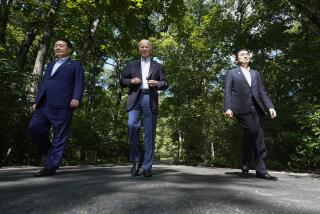Tension Over U.S.-Japan Pact
- Share via
The United States and Japan have revised guidelines for their long-standing mutual security arrangement, raising Tokyo’s military profile--but only in a defensive mode. The Japanese ban on offensive action, a legacy of post-World War II anti-militarism, remains unchanged. But China and Japan’s other Asian neighbors are sure to be uneasy about what the new security concept is supposed to protect: Is it Japan, the Korean peninsula or the region?
The Clinton administration, which once seemed intent on crafting a coherent Asia-Pacific policy, has failed to take a strong lead on the military question. Critics point out that the new guidelines reveal contradictions in U.S. policies.
The revisions, disclosed last week, supersede guidelines established in 1978 that focused on protecting Japan in case of Soviet aggression. The new agreement carefully avoids mentioning where in the post-Cold War world an attack might originate. U.S. officials insist that the security framework “is not geographical but situational.” They point out that the new guidelines establish procedures for cooperation on handling refugees, peacekeeping duties, search-and-rescue missions, evacuation of civilians from areas of potential conflict and other quasi-military tasks, none of which were addressed in the 1978 accords between Washington and Tokyo.
But the continuing absence of any offensive military role for Japan within the agreement has done little to ease concerns of Japan’s neighbors. China is not happy and has criticized the agreement as a threat, particularly to its asserted sovereignty over Taiwan. Tokyo has reassured the Chinese, declaring that it does not support independence for Taiwan. On Washington’s part, Secretary of State Madeleine Albright says the new defense guidelines are not “country specific.”
Certainly the U.S.-Tokyo guidelines will be given close scrutiny, for the combined strength of the two countries cannot be ignored. Chalmers Johnson, president of the Japan Policy Research Institute, believes the guidelines will roil regional tensions. Charles Wolf Jr. of the Rand Corp. suggests using the NATO-Russian model to establish regular U.S.-China meetings, bringing the major players under a single policy tent. Chinese President Jiang Zemin’s October trip to the United States should force the Clinton administration to bring clarity and perhaps greater substance to its Asia policy.
More to Read
Sign up for Essential California
The most important California stories and recommendations in your inbox every morning.
You may occasionally receive promotional content from the Los Angeles Times.













